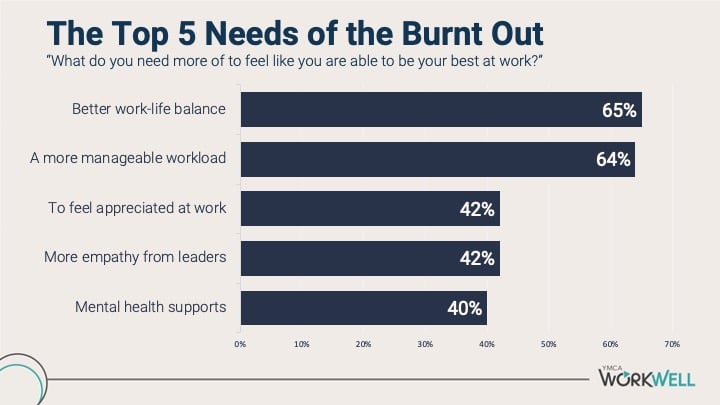This article was originally published on YMCA WorkWell and is reprinted with permission.
The theme for Mental Health Week 2022 was empathy. What a great theme! We all need to build our empathy skills, and we’d all feel more seen, understood and connected if there was more empathy in the world. Particularly in our workplaces, where it sometimes feels like professionalism has been translated into leaving one’s emotions at home on the kitchen counter. Which, of course, is not a thing.
The importance of empathy
There have been several articles written about the importance of empathy in leadership over the past two years (see e.g.: Broom, 2021; Powers, 2022). Greater empathy skills in leaders are linked to a variety of positive outcomes including greater innovation, higher employee engagement, inclusion, and feeling respected and valued.
Our own research at YMCA WorkWell finds that when people are experiencing burnout, a need for more empathy from leaders is tied for third place, along with a need to feel more appreciated personally, and just behind better work/life balance and a more manageable workload (see Figure 1).

What is empathy anyway?
We hear that word a lot, but how do you actually define it? Turns out, that’s not so easy. There are multiple types of empathy. However, many people describe it as being able to step into someone else’s shoes or take their perspective – as Barack Obama put it: Being able to see the world through the eyes of someone who is different than us.
The goals of empathy are to help us connect to each other and to move us to extend kindness, support, or help. This means that one of the easiest ways to extend empathy to someone else is just to say, “I hear you and I’m here for you. How can I help?”
Some common empathy pitfalls to avoid include:
- Assuming you know how the other person feels. You can never reach 100% accurate empathy, so check in with the other person. “How are you feeling about this?” or “You seem to be feeling [frustrated, nervous, sad, angry, excited, etc.]. Is that where you’re at?” Try to avoid saying, “You must feel…” and instead stay open to a range of emotional possibilities.
- Making it all about you. When someone shares something that they are going through, especially something that brings up a lot of emotion, we may naturally connect that emotion to a situation we’ve experienced where we felt that way. Sharing that story may help the person feel more connected, but it can sometimes make it all about you. Try to focus on listening more than talking.
- Trying to fix it. The person you’re talking to may want your suggestions on what to do next, but don’t assume that’s true. Instead, check in about what they need right now. “How can I help?” is a safe bet. You don’t need to fix it to help.
Taking your empathy skills to the next level
If you’re already pretty proficient with your empathy skills, let’s talk about how you can take them to the next level. Remember I said that many people define empathy as being able to take someone else’s perspective? I’d like to suggest that we need to think about it a little differently. Can we ever truly step into someone else’s shoes? As we continue to work in the space of diversity and inclusion, I would argue that we can’t.
So, if we can’t “take” someone else’s perspective, what can we do?
We can seek to understand it. Instead of perspective-taking, it becomes perspective-seeking. This may seem like a semantic argument; however, it makes a big difference in how we approach developing our empathy skills and how we actually practice empathy.
Four steps to practicing empathy
1. Stop judging. We need to start by dismantling judgment. We can’t practice empathy when the voice in our head is chattering on about all the ways the other person has it “wrong”. Empathy is about seeking to understand another’s perspectives, values, and beliefs; we don’t need to take on those perspectives, values or beliefs ourselves. We don’t have to agree to empathize.
To practice this, we need to start with mindfulness – an awareness of when we’re shifting to judgment. What’s your internal narrative when you’re in judgment mode? How can you catch yourself and cultivate curiosity instead?
2. Ask open questions. The best way to cultivate curiosity and seek to understand is to ask great questions. Great questions are open-ended (i.e., can’t be answered by a simple “yes” or “no”) and invite meaningful dialogue. Some examples include:
- “I hadn’t thought about it that way. Can you tell me a bit more?”
- “Can you explain your thinking on that?”
- “Sounds like you have a different perspective than I do. Can we talk more about what we’re seeing?”
- “I can imagine what that would feel like for me. How does it feel for you?”
3. Listen actively. The key with active listening is to listen to understand, rather than to respond. This means we need to quiet that inner voice in our head that is reacting to what someone else is saying and thinking about what we are going to say next (dismantling judgment, again), and focus on truly hearing what the other person is saying. Mindfulness is really helpful here. If you find that you struggle with active listening, set a goal to paraphrase what someone has said back to them when you’re practicing empathy.
4. Connect to emotion. Brené Brown defines empathy as “connecting to the emotions that underpin an experience.” When we connect to the emotions as well as the substance of what someone else is experiencing, we connect to who they are in that moment. There are so many emotions available to us, and identifying how we are feeling can help us and others with understanding where that emotion is coming from, accepting it, and also letting it go.
So, let me give you an example. My partner is writing a non-fiction book and he’s in the editing phase. I agreed to help him with editing, and we are two chapters away from being finished. As I was reading this second-last chapter, I was frustrated because I felt like I was reading what I had already read several times before. I gave him feedback that I thought the chapter could be better structured to reduce the repetition and more effectively convey the “how” of the topic.
He responded in a way that sounded almost angry to me and it might have been natural to get defensive about “just trying to help”. Instead, I mindfully tried to connect to how he could be feeling and I said, “It sounds like you feel discouraged and like this process is never going to end. Is that how you’re feeling right now?”
In that moment, we connected around this shared experience from our different perspectives. Notice that I didn’t assume how he “must” be feeling and that I used his body language, facial expression, tone and words to help guide me to the underlying emotion – and then I checked my understanding, allowing him to confirm my “read” or to say, “Actually, how I’m feeling is…”
This may seem like a lot…and it is. It can be hard to practice in the moment. You can work on all four of these skills, but know that any improvement you make on any one of them will make a difference. The key is to know is that empathy is a skill, and we can build that skill through practice.
The wonderful thing about empathy is that we get to foster that sense of connection to another person, something that we all need as human beings. And we get to really know that we are not alone in life’s joys, challenges, and sorrows.
I hope that you take some time this week to #tune in to someone else and flex your empathy muscles. You’ll be glad you did.
Dr. Kate Toth, CHRL is YMCA WorkWell’s Director of Learning and Development. She loves to blog almost as much as she loves to develop and deliver training to help organizations enhance their culture and foster employee well-being. Her passion is to inspire others to think deeply and learn continuously. Kate has a PhD in Health Psychology and a MS in Industrial/Organizational Psychology. With a weakness for red wine and chocolate, Kate’s active lifestyle is a non-negotiable in her quest for balance.








